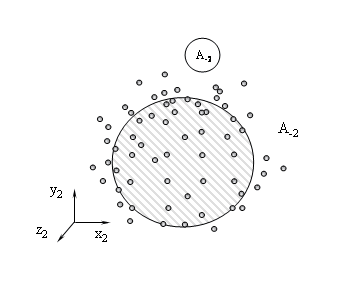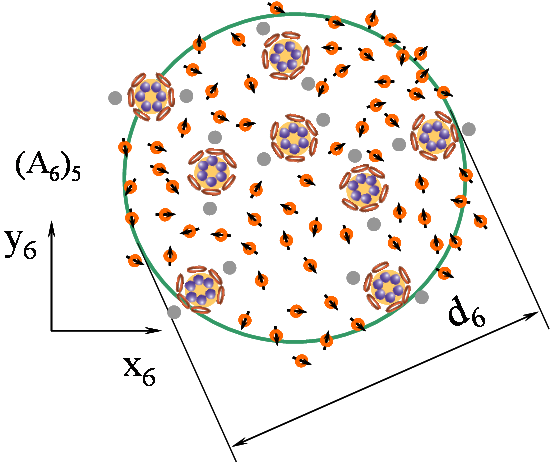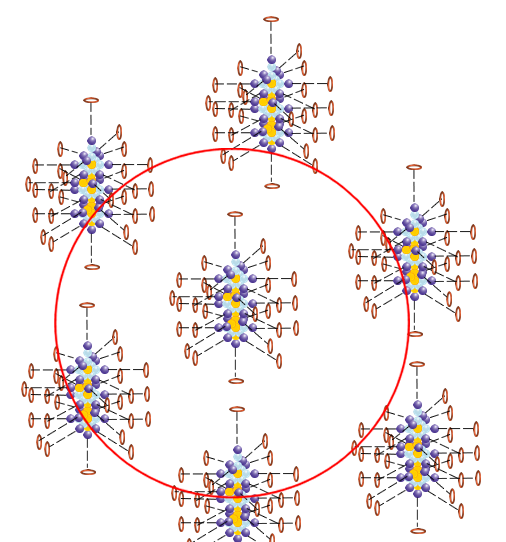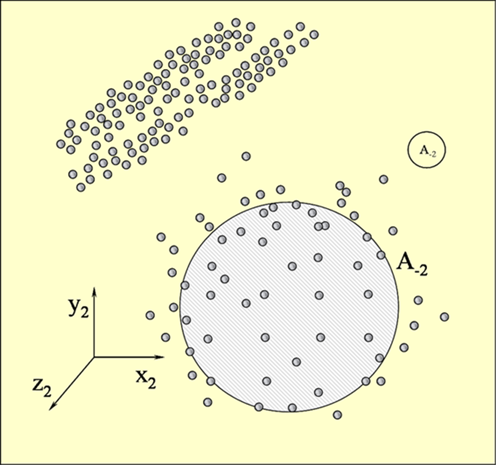
The Annals of Exploratory Science

"Elementary" Particles in Space (Aether) Schematic.

Modeling of water (HSP-VAT) as a bunch of molecules and some other particles as electrons.

Modeling of Fe56 in the aether (HSP-VAT) as a bunch of interactive atoms. Is this physics more complicated than the gang of just points? And comprehend that the scales here are for depiction of the ideas, not the real scales, aren't you?
Readers, especially students that are good in math - watch the critical feature that changes the vision and methods in physics. Notice that the particles can be - should be intersected by a bounding surface when we do any kind of assessment, integration, averaging. In Conventional Orthodox Homogeneous Physics (COHP) you NEVER see this intersection, never see this kind of picture, scheme for integration.
Because the mathematics and apprehension of COHP don't allow this to accept, think about, and perform. In COHP there are no tools, theories, methods to do physics with sliding REV and cut objects while averaging the processes' spatial fields/functions.
That is why the Conventional Homogeneous (because only the point-mass-charge particles or even volumetric particles are allowed to exist) Statistical Mechanics (CHSM) is so unnatural pure mathematical discipline.
And incorrect anyway because the only GO theorem
is used for assessments and the statistical sums are often incorrect, the ground
breaking and used everywhere equation of Boltzmann is proven as to be incorrect
Travkin, V.S., "Boltzmann Equation is Invalid in the Derivation. More than 100 Years
of Misled Research?,"
Boltzmann Equation is Invalid in the Derivation ,
Hamiltonians, Hamilton and Liouville equations it is the science mostly from the XVIII and for the mass-points only medium - while in a real sub-atomic world the particles and atoms are the volumetric objects and have their 3D rotations, magnetic moments and spins, so all these XVIIIth century tools, definitions, point-mass mechanics are inadequate simplifications for the Heterogeneous media of atomic and sub-atomic world, everywhere in CHSM is the "action-at-a-distance," interaction potentials (?) without intermedium, so acting throughout the "nothing," not through the vacuum - vacuum is not taken into consideration as an existing intermedium, because the aether - which is not still a vacuum, is prohibited , etc., etc.
This can be considered as the most outrages and outdated thing in CHSM that physicists can not accept and apprehend the obvious knowledge that the sub-atomic particles exist all along and together simultaneously with the intermedium - which is correctly the aether. H. Lorentz on his part was considering an aether as the completely valid physical subject. What was said above means the two-phase at least (and polyphase) Heterogeneous media and this kind of science atomic and particle physics professionals cannot apprehend - they are lack of education on many issues in physics.
Why we tell so straight and bold statements about inadequacy CHSM point-mass arrays of one phase one scale particles in volumes, spaces filled with "nothing," but particles only? Because, apart of pure physical and mathematical reasons that we are spelling all around for many years, within the HSP-VAT we went through the most of these problems and had solved many of them for the satisfaction of mathematical strictness, physics eminence and value of different than the Homogeneous physics, mechanics results.
At the same time students are never told about all of this - excluding just some of universities where me and my associates happened to be lecturers, it is the prohibited education in the universities.
Meanwhile, this is natural and of necessity to have the bounding surface crossing any phase, another surface or even points in the Heterogeneous media, no matter - What are the scales of that media processes or phenomena, as have been shown, solved and apprehended in many physical and technical sciences throughout the last >45 years. This assessment and integration is ALWAYS to be the part of study in physics, any science. Remember this.

Arrays of photons in space dynamics - two-scale modeling reveals the wave character of some dynamics regimes.
Vladi S.
Travkin,
 Natalya N.
Bolotina
Natalya N.
Bolotina


 Hierarchical Scaled Physics and Technologies (HSPT), Rheinbach, Germany,
Denver, CO, USA
Hierarchical Scaled Physics and Technologies (HSPT), Rheinbach, Germany,
Denver, CO, USA

 University of Applied Sciences, Rheinbach, Germany
University of Applied Sciences, Rheinbach, Germany
ABSTRACT
The aim of this communication is to explain and describe the elements of scaled electrodynamics for the two-scale presentation of the media consisting of structured single electron and photon in an aether (vacuum0) and/or an array of electrons and photons possibly moving in 1D as well. Those are among of the basic problems of fundamentals of polyscale dynamics of structured sub-atomic particles. The second Upper scale models of the three-"phase" medium are constructed according the well developed for macro- and meso-scale physics Hierarchical Scaled Physics - Volume Averaging Theory (HSP-VAT) techniques of averaging of the Lower scale model attributes, equations. As long as we have in this situation the three-phase Heterogeneous medium the hierarchical mathematics of averaging is different of Homogeneous mathematics that has being applied for ~200 years in physics for homogeneous as well as heterogeneous media regardless of structure and phases properties. Only in the latest ~30 years the polyphase methods have been applied more for heterogeneous media, but in most cases not correctly and for only continuum mechanics tasks.
After short review of ideas, postulates, techniques and critics that has been sounding
from the commence of QM, we explain the main features of difference between QM and
presented HSP-VAT Polyphase, Polyscale treatment of charged particles in a homogeneous
medium of an aether, which is accepted here as a homogeneous as long as the
speculative heterogeneity of aether might be taking place at much lower
(smaller) scales than the accepted and discussed in the present work scales

 m.
m.
The structure models for electron and photon are based on studies already of a long history with models that are looking at present as having the many characteristics that already known for these particles. Nevertheless, the treatment of electron and photon arrays, much more difficult in motion, is up to now has deficiently combined theories. As long as electron and photon are not the point-mass', but particles of some known sizes - that means they should be treated, studied as volumetric particles with properties.
We explain why we applied the Galilean electrodynamics theory developed by Ja.G. Klyushin for homogeneous systems and for two particles force field theory following the HP-VAT techniques for charged particulate medium (phase) of unbounded electrons and photons along with some model of the aether dynamics. Some governing equations are compared with the previously created in the 90s by one of the authors the scaled hierarchical electrodynamics theory for the Maxwell-Heaviside-Lorentz (MHL) electrodynamics that itself was created and has being valid (partly) only for homogeneous media systems.
Key words: Polyscale physics; Electron; Electrons in Vacuum; Photon; CMBR; Aether; Heterogeneous media; Averaging theories; HSP-VAT; Multiscale; Polyscale modeling; Electrodynamics; Heterogeneous electrodynamics; Sub-Atomic modeling; Particles modelng; Gauss-Ostrogradsky theorem; WSAM theorem; Scaleportation.
The following article will describe and explain in more or less simple text the scaled subjects regarding the two-scale electron and photon clouds in an aether theory:
Travkin, V.S. and Bolotina, N.N., "Electrons and CMBR (Cosmic Microwave Background Radiation) Flux of Photons in a Vacuum0 (Aether) - Two-Scale Galilean Theory ," http://travkin-hspt.com/parphys/elcmbr/elcmbr.htm
Access to manuscript may be obtained for qualified parties. Apply for authorization.
Some of the relevant HS physics and mathematics outcomes, methods, and derivation procedures can be found in the references below and in some closely narrated materials.
1. Kanarev, Ph.M., The Transfer of Information in the Space. 7th New Lecture on Unity Axiom," http://www.micro-world.su/ Folder "Lectures", retrieved 05/05.2013
2. Kanarev, Ph.M., "Model of the Electron," Apeiron, Vol. 7, No. 3-4, pp. 184-194, (2000)
3. Kanarev, Ph.M., "A Model for the Free Electron," Galilean Electrodynamics, Vol. 13, No. S1, pp. 15-18, (2002)
4. Kanarev, Ph.M., "Electrons in Atom," Journal of Theoretics, Vol.4-4, pp. - , (2002)
5. Kanarev, Ph.M., "Modelling the Photon and Analyzing Its Electromagnetic and Physical Nature ," Journal of Theoretics, Vol.4-1, pp. 1-12, (2002)
6. Kanarev, Ph.M., Photon, http://www.micro-world.su/ Folder "Books"; retrieved 05/05/2013
7. Kanarev, Ph.M., Nuclei of Atoms, http://www.micro-world.su/ Folder "Books"; retrieved 05/05/2013
8. Kanarev, Ph.M., Answers to Microworld Questions, http://www.micro-world.su/ Folder "Answers"; retrieved 05/05/2013
9. Kanarev, Ph.M., Introduction to New Electrodynamics, http://www.micro-world.su/ Folder "Books"; retrieved 05/05/2013
10. Travkin, V.S., Electrodynamics 2 - Elements 3P (Polyphase-Polyscale-Polyphysics), http://travkin-hspt.com/eldyn2/index.htm, (2013)
11. Travkin, V.S., What's Wrong with the Pseudo-Averaging Used in Textbooks on Atomic Physics and Electrodynamics for Maxwell-Heaviside-Lorentz Electromagnetism Equations, http://travkin-hspt.com/eldyn/maxdown/maxdown.htm, (2009)
12. Travkin, V.S., Incompatibility of Maxwell-Lorentz Electrodynamics Equations at Atomic and Continuum Scales, http://travkin-hspt.com/eldyn/incompat/incompat.htm, (2009)
13. Travkin, V.S. and Bolotina, N.N., "The Classical and Sub-Atomic Physics are the Same Physics," http://travkin-hspt.com/parphys/pdf/51_PrAtEd-QM-Ref-2HSPT.pdf, (2013)
14. Travkin, V.S., "What is the Particle Physics Now? Three Important Assumptions and Five Postulates That Have Destroyed Conventional Orthodox Homogeneous Physics (COHP)," "What is the Particle Physics Now? http://www.travkin-hspt.com/parphys/whatispp/whatispp.htm"
15. Travkin, V.S., Statistical Mechanics Homogeneous for Point Particles. What Objects it Articulates? http://travkin-hspt.com/statmech/index.htm, (2014)
16. Travkin, V.S., Solid State Polyscale Physics. Fundamentals, http://travkin-hspt.com/solphys/index.htm, (2014)
=================================================================================================
Any information displayed here is the proprietary information in the area of "Electrons and CMBR (Cosmic Microwave Background Radiation) Flux of Photons in a Vacuum0 (Aether) - Two-Scale Galilean Theory."
This is not the well known problem, but within the COHP the versions of it have been even formulated wrongly - read our analysis and texts on Conventional Homogeneous Statistical Mechanics great unbelievable simplifications of 1910-1970 and beyond - and it can not be advanced, solved within the Homogeneous One-Scale MHL electromagnetism and/or particle physics.
![]()

![]()